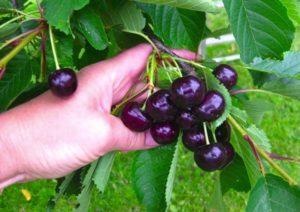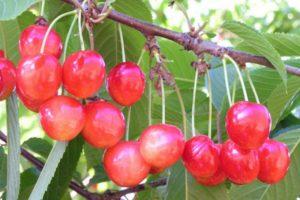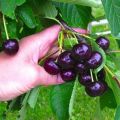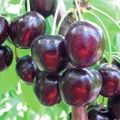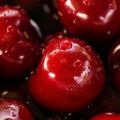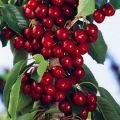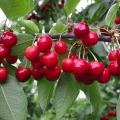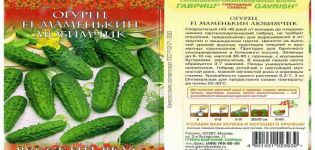Description and characteristics of the cherry variety Chermashnaya, pollinators and cultivation
Cherry Chermashnaya - early ripening variety, gives bright, yellow fruits, pleasant to the taste. It has good resistance to frost, drought and infectious diseases. It is very popular among gardeners. The main yield peak falls on the 6th year of the growing season.
The history of breeding the variety Chermashnaya
Since 2004, the Chermashnaya variety has been distributed throughout the central territory of Russia. The breeders of A. I. Evstratova, H. K. Enikeeva, N. Morozova were engaged in the cultivation of sweet cherries. The works were carried out on the basis of the All-Russian Institute of Selection and Technology of Horticulture and Nursery. Refers to early-ripening varieties of sweet cherry.
Main pros and cons
The Chermashnaya variety has its pros and cons. The pluses include:
- early maturity;
- high productivity;
- winter hardiness;
- taste of fruits;
- strong immunity.
There are also several minor disadvantages:
- the obligatory presence of a pollinator for the formation of the ovary;
- short storage of berries.
Description and features of the tree
The description of the plant includes characteristics such as height, crown, pollination, flowering, yield, fruiting and storage of berries.

Height and branching of the crown
The trees are undersized, reaching a height of 4-5 meters. They grow and develop rapidly, gaining a height of up to 1 meter in one year. The crown is rounded or oval, raised. The branches grow sparsely. Shoots are woody, straight, dark brown. The leaves are large, green, lanceolate. The surface of the plate is smooth, matte, the edges are wavy.
Pollinating varieties
Cherry Chermashnaya is a self-infertile variety. To obtain an ovary, it must be planted next to pollinating trees.
Important! Pollinator and cherry blossoms should be in the same period.
Pollinator varieties include:
- Raditsa;
- Iput;
- Crimean;
- Chocolate girl;
- Crimean;
- Bryansk pink;
- Leningrad black;
- Fatezh.
Flowering, fruits, productivity
The period of fruit ripening begins in the third year of vegetative development. Until that time, she just blooms and gains strength.Forms white flowers, which consist of 5-6 petals, with a yellow core. One inflorescence contains from 2 to 6 flowers. Then the fruits are formed. Flowering occurs before leaf formation begins.

It forms fruits of medium size, light yellow in color, with increased access to sunlight, the berries have a pink tint. The maximum weight of one berry is 4.5 grams. The shape of the fruit is round. The pulp is juicy, sweet, yellow. The skin is dense, inside there is a small stone, which is easily separated.
Most of the yield falls on the 6th year of development. Up to 30 kg of fruits are removed from one tree. The average age of Chermashnaya cherries is 25 years. Ripening of berries occurs in several stages, so the harvest is harvested gradually.
Transportability and scope of berries
Most often, sweet cherries are used fresh. It is also processed into compotes, jams, preserves. The berries are stored in a cool place for up to 4 days. If it is necessary to freeze the berries, it is advisable to keep the cuttings, then they can be stored for up to 4 months. After defrosting, they retain their sweet taste.
For transportation of berries, cuttings must be preserved, and the harvest is carried out in dry weather.
Culture characteristics
Important characteristics of the crop include resistance to frost, drought, and immunity to diseases and insects.
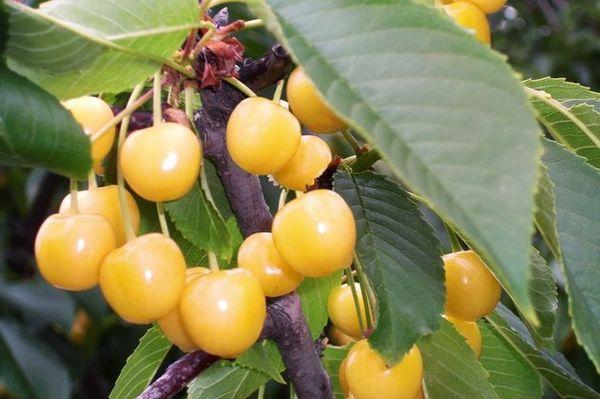
Resistant to low temperatures and drought
Trees tolerate low temperatures well below -20 ° C. However, their buds are not so stable, and if severe frosts are predicted during their formation, it is recommended to take action. Also, for regions where winter temperatures drop below -20 ° C, it is necessary to cover the tree for the winter.
The tree is moisture-loving, it tolerates a hot dry climate normally with sufficient watering. However, it is not recommended to plant seedlings in places of stagnant water, the development of the tree will be slowed down.
Susceptibility to disease and insect infestation
Cherry is resistant to fungal diseases, especially to moniliosis and coccomycosis. In hot weather, it is prone to attack by harmful insects that feed on the leaves of the tree. It is recommended to carry out preventive spraying to prevent their attack. Under optimal conditions, the plant rarely gets sick.
How to plant cherries on the site
In order to plant cherries on the site, you must follow the planting rules, terms, choose and prepare the right place, choose a worthy seedling.
Recommended timing
Saplings are planted in autumn or spring. In the fall, planting a tree is more risky, as it can suffer from frost if it does not have time to take root. The maximum period for autumn planting is October. After the manipulation, it is necessary to insulate the cherries.

Only 10-14 days are given for spring planting. You need to catch the moment when the snow has already melted, the soil has warmed up, and the movement of sap in the tree trunks has not yet begun. This period falls in mid-April or early May, it all depends on the region.
Important! In the presence of blossoming buds, planting will be unsuccessful, the cherries will not take root.
Selection and preparation of a site and a landing pit
Chermashnaya prefers well-lit areas with full daylight hours. Places with constant drafts and lands with frequent flooding with water are not suitable for a tree. Sweet cherry grows well on loose loamy soils. Peat, sand and clay are not suitable for planting. Also, the plant does not take root in acidic soil, but this is easy to fix. Dolomite flour is added to the ground.
A pollinator must grow near the tree. The distance between adjacent trees must be at least 3 meters.
The pit has been prepared since autumn. Dig a hole 70 cm deep and about 1 meter in diameter. The lower layers of the earth are removed, and during planting they are replaced with drainage. Gravel or pebbles are used for drainage.The top soil is mixed with fertilizers. Use 2 buckets of humus and 1 bucket of wood ash. If the soil is not fertile, then add 100-120 grams of superphosphate. If the soil is dry, then it is watered with 50 liters of water and left until spring.
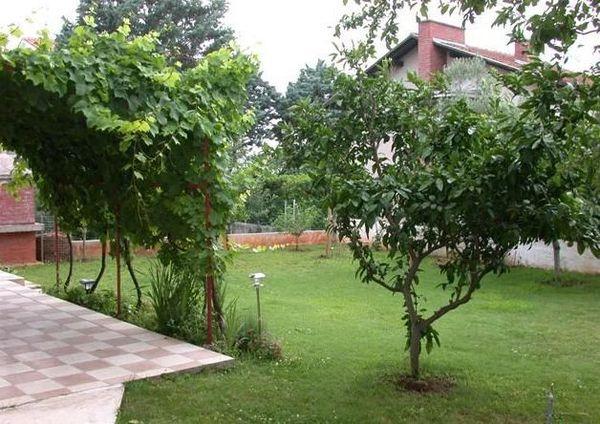
Choosing a healthy and strong seedling
Seedlings are best purchased in specialized stores or from trusted sellers in the markets. When buying, it is better to choose a 1-2-year-old plant, so the chances that it will take root are higher. In spring, you should pay attention to the absence of buds on the seedling, this reduces the risk of its engraftment. The seedling itself should be with dense living branches, without mechanical damage and cut off sections on the trunk. The roots must be intact and strong, free from rot.
Neighborhood of cherries with other cultures
Sweet cherries tolerate well being adjacent to other varieties of cherries and cherries. It should not be planted next to plums, apple trees, apricots, walnuts.
Important! The best neighbors for Chermashnaya are other varieties of cherries.
Landing technology
Landing is carried out according to the following algorithm:
- A drainage 10-12 cm deep is laid in a hole prepared in advance.
- A support stick is installed to protect the seedling from strong winds.
- The roots of the seedling are straightened.
- Place the seedling in the hole.
- Sprinkle with soil mixed with fertilizers in layers.
- Each layer is trampled underfoot to create a firm soil adhesion.
- The root rod should rise 7-8 cm above the soil.
- A recess is left around the trunk with a diameter of 25 cm.
- Watered with water so that the soil is moist to a depth of 50 cm.
- The central shoot is cut to form a lush crown.
- The seedling is tied to a support stick.
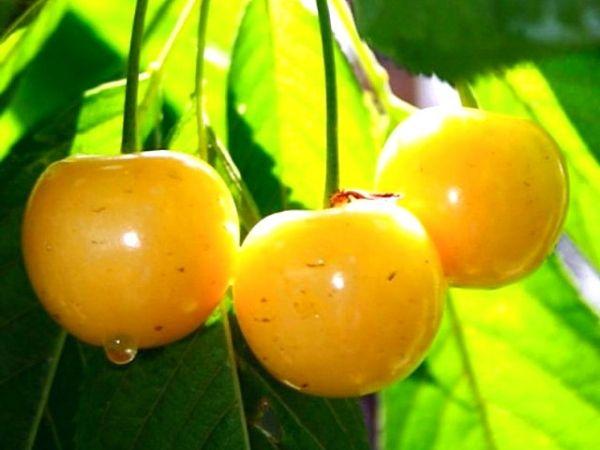
We organize tree care
For the successful development of a tree and a good harvest, it is necessary to organize proper care for cherries: timely watering, fertilizing, looking after the tree trunk, pruning, and covering for the winter.
Watering
Watering is carried out every 2-4 weeks in the amount of 7-8 buckets. During the ripening period, the amount of water is increased to 10-12 buckets. Two weeks before the fruit ripens, they stop watering completely. In the fall, when the cherries are preparing for winter, the amount of water is reduced. Since the cherry variety Chermashnaya tolerates drought quite easily, nothing will happen to the tree if there is no possibility of watering. It is especially important to observe the watering regime before the beginning of fruiting.
Top dressing Chermashnaya
For fruiting and young trees, fertilization is carried out according to different schemes.
Fertilizing under young trees
Young seedlings need additional nutrients for accelerated growth and strengthening. They are fed with urea in the spring. Fertilizer is provided both in dry form and in dissolved form. Cherry takes the rest of the substances from the fertilizers introduced during planting. This is enough for her for 2-3 years.
Beneath fruiting trees
Fruiting trees consume more minerals from the soil, as they need to form fruits. In the fall after harvest, the urea addition is reduced by 2 times and begins to be fed with other fertilizers. 200 grams of superphosphate, 100 grams of potassium sulfate, 1 kilogram of wood ash are buried under the ground of the trunk circle. For the winter, the tree is mulched with 3-4 buckets of humus. In the spring they close it up.
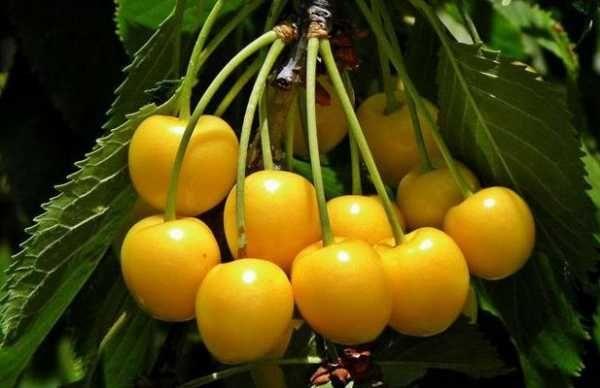
Barrel circle care
After planting, the trunk circle is mulched with various compounds. These include: humus, peat, pebbles, dried grass, straw. This provides additional moisture retention and prevents drying out. Also, this method protects cherries from the development of infections and attacks of harmful insects.
Pruning and shaping undersized cherries
The first pruning is carried out immediately after planting. The central shoot is cut off. In young trees, new shoots are cut off by 1/5 every year.In this way, a low-growing plant is formed, which makes harvesting easier. An adult tree is pruned after picking berries, dry and damaged branches are removed. With dense growth of branches, they are thinned out.
Preparing for winter
After the last winter watering and digging up the trunk circle, it is mulched with humus or straw. The trunk is treated with whitewash, this helps to scare off rodents that feed on the bark. For greater reliability, the barrel is additionally wrapped with special agrofibre.

How to propagate a culture?
Cherry propagation is carried out by cuttings. Prepare in advance a landing site with suitable soil. Pits are dug 40 cm deep. Drainage is placed at the bottom of the pit. A small frame and film are prepared. Cuttings are cut with a length of 30 cm. Each of them should have 5-6 leaves. All cuttings are placed in water with a root growth stimulant. They use it strictly according to the instructions.
After the development of the roots, the cuttings are transferred to the prepared wells. The frame is installed and covered with foil, creating a mini-greenhouse. Within 21 days, the cuttings take root. Then they are planted in the designated places. Cuttings are buried to a depth of 20 cm, leaving a depression in the hole.
Reviews of summer residents about the variety
Alexey, 38 years old, Tver: “I planted cherry varieties Chermashnaya 6 years ago. The seedling took root easily and quickly. He carried out the work in early spring, before the formation of buds, introduced top dressing, closer to summer the tree blossomed. It is growing rapidly. Every year he cut off the shoots so that it did not grow tall. Since last year, she began to produce berries. They taste great and are yellow in color. We did not try to store everything, everything that we collected was immediately eaten and processed. The jam is very tasty. "
Artem, 56 years old, Chelyabinsk: “This year I bought several Chermashnaya cherry saplings on the market and planted it next to the pollinator. Landing was carried out for the winter. Prepared the pit. Dropped out, carried out mulching. He insulated it for the winter, because he was worried that he would freeze. In the spring, buds began to form, and by the beginning of summer it had blossomed. I hope the variety will pay off. "
